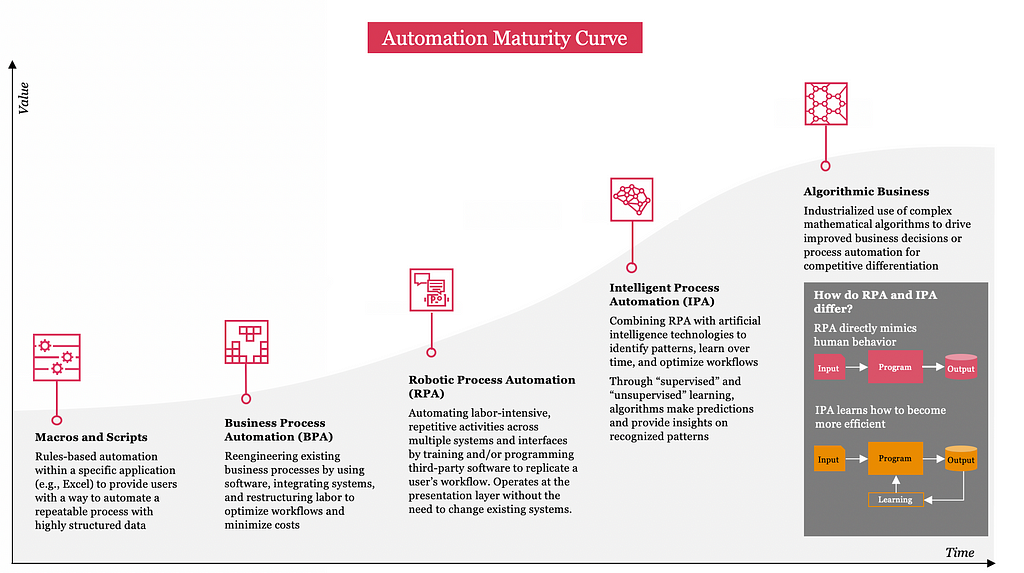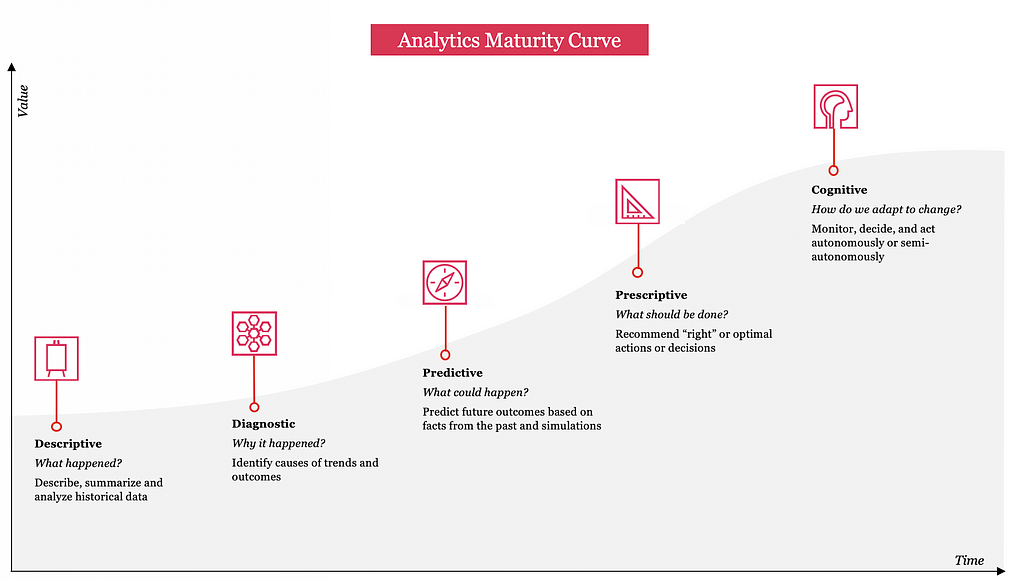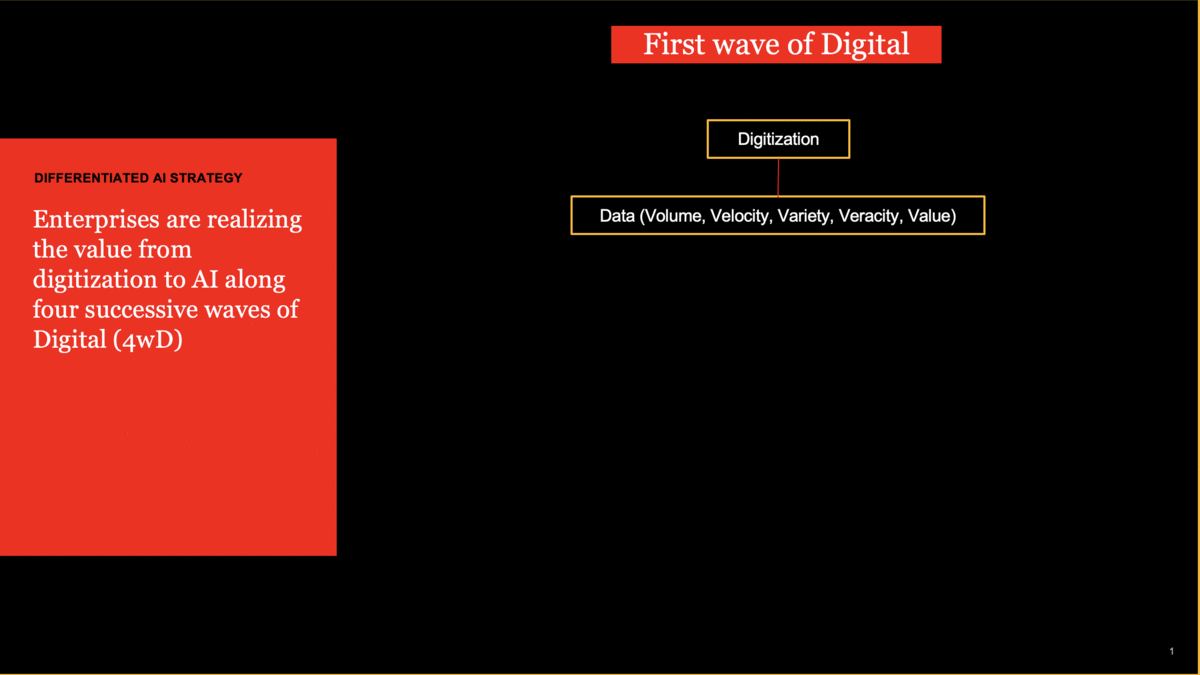
Data, Automation, Analytics, AI — The Unbeatable Quartet
Last Updated on February 17, 2021 by Editorial Team
Author(s): AnandSRao
Future, Technology
Data, Automation, Analytics, AI — The Unbeatable Quartet
Competitive Advantage from the Four Waves of Digital (4wD) (Part 1)

The business world has been bombarded with one revolution after another. The Digital Revolution has become the catchphrase and every organization has already been through a digital transformation or is currently going through one. However, the word digital revolution or digital transformation can mean many things to many people. Digital revolution is a broad term that encompasses all the advances in information technology since the introduction of computers in the late half of the twentieth century.
In a series of articles, I will look at the four inseparable parts of the digital revolution — the star performers of an unbeatable quartet. Automation and Analytics are the two violins of the string quartet — providing the efficiency benefits and effectiveness benefits, respectively. Data is the viola of the quartet and integral to the harmony and often accompanies both automation and analytics. Artificial Intelligence is the cello of the quartet, the closest to the human vocal range, that integrates the other three aspects. All four are critical to create a competitive advantage. But we have seen many companies treat them independently or in pairs and not really appreciate the beautiful music of the quartet. For the ocean lover we equate these to the four waves of digital. For the outdoor enthusiast this becomes 4wD (4 waves of Digital). Whatever analogy suits you best — the key message we want to drive home is that these four must be together and as an integral component of your competitive advantage.
Data and Big Data — The First Wave of Digital
The history of using data as an asset and developing computable knowledge goes back 20,000 years. The Ishango bone from the central tribes of Africa used it as a means of counting. The long and fascinating history of systematic data and computable knowledge is a five-foot long timeline that can be found at this WolframAlpha site.
While data and its uses have existed much before the advent of computers, the digital revolution (or the computing part of it) accelerated the use of storage and use of data during the last couple of decades of the twentieth century. This data was largely structured and organized in a standardized format in databases. The first reference to a “data base” dates back to 1962.
The internet ushered in a new phase of the digital revolution during the late 1990’s. This brought with it semi-structured data and also a lot of unstructured data in the form of text and images. With the advent of smartphones the amount of data increased exponentially adding more unstructured data in the form of audio, images, and video. Also with both the internet and smartphone eras we have seen the focus of the data shift from businesses to consumers. Data also became more social and behavioral — capturing the relationships between individuals, groups of individuals, their sentiments, their preferences, attitudes, etc. This led to what has been called the ‘Big Data’ Revolution and the five V’s of ‘Big Data’ — Volume, Variety, Velocity, Veracity, and Value.
While some claim the end of the big data era, it is the specific technology around Hadoop that is being transformed and not necessarily the use of large amounts of data or the use of streaming data. These aspects of Big Data are not only flourishing, but also accelerating with IoT, Industrial IoT, and 5G. We will see more of sensor data streaming from billions of sensors and connected devices. Just as we saw the shift from business data to consumer data — we will also see a shift from human-generated data to machine-generated data. Business data or human-generated data will not disappear, but they are and will be dwarfed by the volume of consumer and machine-generated data.
In summary, over the past half a century we have seen the digitization of everything that we do and across all sectors of business, science, and technology. From agriculture to high-tech, every industry sector is being transformed by the digital revolution. This digitization (irrespective of whether an industry is data or information intensive (e.g., financial services)or not (e.g., agriculture, mining)) is leading to more and more data that is growing and continues to grow at an exponential rate.
When you have lots and lots of data, organizations typically choose the automation path or the analytics path or both to exploit the data. This takes us to the next two waves of Digital.
Automation — The Second Wave of Digital
With lots and lots of data, organizations must first standardize their business processes. As they start the journey of standardization they will realize that there are a number of exceptions to processes which may no longer be required or valid. In addition, some steps in the business process can be eliminated. These changes will inevitably lead to the simplification of the business processes. Removing exceptions to processes and changes to processes which give more control to business users and power users (see my article of Democratization of AI — A Double-Edged Sword) could further simplify the business processes. Once simplified these processes can be automated.
The word automation was first coined in 1946 by an engineering manager at Ford Motor Company. However, the notion of business process re-engineering was popular in the 1990’s with Michael Hammer’s call to ‘Don’t Automate, Obliterate’. This was followed by the wave of business process management and workflow management in the 2000’s — the precursor to RPA. The word Robotic Process Automation (RPA) itself came into vogue during the early 2000’s . It has been evolving over the years from simple macros and scripts, to robotic desktop automation, and then RPA. This journey is evolving with Intelligent Process Automation which uses machine learning and natural language processing to extend RPA.

The business benefits of automation are primarily efficiency focused. Automation reduces the time required to do repetitive tasks. These repetitive tasks can be manual or cognitive. An example of a repetitive manual task is cutting and pasting information from one application to another application. An example of a repetitive cognitive task might be a credit analyst in a bank collecting rating agency data, transaction data, government data etc. before making a decision on a loan application. Automating these tasks result in time savings and a reduction of turnaround time on processes. This in turn improves staff or labor productivity and decreases overall labor costs. These direct cost (or bottom-line) benefits can also lead to indirect top-line benefits. Reducing the turnaround time can result in greater customer satisfaction and better custmer retention leading to better profitability. Robotic desktop automation and robotic process automation can automate a large proportion of these repetitive manual and cognitive tasks.
When it comes to non-repetitive or variable tasks we need techniques like machine learning and natural language processing — more the domain of AI — to automate them. Process mining uses machine learning techniques to take a workflow log or transaction log and find exceptions, bottlenecks, resource contention, turnaround time etc. that can then be used to better triage the tasks and assign them to the right skill types within an organization. For example, a customer service trouble ticketing system for trading in an investment bank received multiple trouble tickets or service requests in a day. These requests had to be handled within a certain duration (e.g., within 24 hours) due to regulatory requirements. The trouble tickets varied from simple fixes to more complex ones that required the skills of subject matter experts or technical staff. This is a classic example where you have some ‘routine’ fixes and some ‘non-routine’ fixes. The investment bank was able to use NLP and machine learning to parse the trouble tickets, categorize them by level of complexity, and route it to the right pool of experts to expedite the resolution of problems.
Automation can yield significant benefits in terms of reduced time for tasks, greater productivity of staff, and hence reduced labor costs. However, there is still a significant investment involved up front that can be recouped from savings. Computing the return on investment (ROI) for such initiatives requires a good baseline of time taken for certain activities and also the productivity benefits may not always translate into reduced headcount (See my article on Consequence of mistaking models for software).
Analytics — The Third Wave of Digital
With lots and lots of data — standardization, simplification, and automation — is not the only path. Organizations can also choose an alternative path of exploiting the data. This path uses the data to personalize the interaction and experience with the users. Users here could be your customers, your suppliers, or your employees. The personalization occurs in three distinct phases. First, one uses the data to understand the behavior of users. The understanding phase is followed by predicting the behavior of users. Third, and final stage is to actually change (or nudge) the behavior of users. For example, consider your favorite streaming service — the company first understands your preferences, your watching habits, genres of your liking etc., and then predicts what you are likely to watch and makes appropriate recommendations. As you grow more dependent on a particular streaming service they can also subtly change your viewing habits and also produce content that will keep you engaged.
Personalization could lead to what Kevin Kelly calls cognification — making things smarter. Imagine the difference between viewing a detailed catalog (running into the millions) of all movies produced to date in all languages, to your favorite streaming service that can recommend movies to you based on your interests and the genre (e.g., the latest action movie or the latest Bollywood movie with your favorite hero!!). The recommendation is tailored to each of our individual preferences and will also change over time as our preferences change and the type of content generated changes. This is what makes them ‘smart’. This process that we all understand now is happening not just in the consumer world, but also in the enterprise world (or B2B or B2B2C value chains).
Unlike the automation path, the key competitive driver in the analytics path is being able to draw insights from data, turn those insights into better decisions and actions to produce a better outcome to the customer and to the company. So the emphasis is on Decision Making or taking actions that are better than what we would have taken in the absence of the data and the analytics on that data.
The business benefits of analytics are primarily effectiveness focused. They assist in improving the experience of users, make better decisions, or take better actions. This results in better customer retention, better value for customers and therefore better prices/margins for providers, and ultimately more revenue and profits for companies that are able to personalize and cognify their products and services. Like Automation quantifying the ROI on analytics is a non-trivial task as the effectiveness improvement is based on a human baseline performance. Unfortunately, in a number of cases we do not have a baseline for human decision making in many areas (See my article on Consequence of mistaking models for software).
Analytics is often categorized in four stages of increasing sophistication — descriptive analytics (asking the question what happened?), diagnostic analytics (why did it happen?), predictive analytics (what will happen?) and prescriptive analytics (what can we do?). In some cases a fifth phase is added called cognitive analytics (how do we adapt to change?). This is a broad bucket to include all of the AI techniques that can be used in conjunction with some of the traditional analytics techniques. This leads us to the fourth wave of Digital.

Artificial Intelligence — The Fourth Wave of Digital
As we get to the top of the maturity curve of both automation and analytics we invariably morph into AI. In automation as we move towards intelligent automation we are increasingly using machine learning and Natural Language Processing, the domain of AI. Similarly, as we move into cognification or more into prescriptive and cognitive analytics we are in the domain of AI.
The definition we like to use for AI is a classic definition of AI articulated by Stuart Russell and Peter Norvig in their book. We consider AI to be any software system or agent that is situated in an environment, interacting with other humans and machines, that can sense, think, and act in order to achieve a certain purpose or objective.
AI has been around since 1956 — the term was first used by a small group of academics and founding fathers of AI in a conference in Dartmouth. However, AI is still considered an emerging technology in many companies. AI has gone through at least two boom-bust cycles in the past and has been on an upsurge in popularity since 2007.
The benefits of AI come from both efficiencies and cost reduction, as well as effectiveness and revenue/margin increases. The challenges of ROI estimation and realization that we outlined earlier continue to exist for AI — with the added challenge of addressing the ‘hype’ around AI and the magical qualities attributed to the anthropomorphization of AI.
While data powers the automation, analytics, and AI waves; AI is the glue that binds both automation and analytics. The following graphic captures the four waves of digital and how all the four waves are inter-related.

In this article, we have introduced the four major waves of digital and argued that any competitive advantage due to one of them should consider the interplay with the other three. In subsequent articles, I will go deeper into these topics and examine how to develop the strategies for each of these waves, the key economic levers for each, and the mechanisms for building a competitive advantage.
Data, Automation, Analytics, AI — The Unbeatable Quartet was originally published in Towards AI on Medium, where people are continuing the conversation by highlighting and responding to this story.
Published via Towards AI
Take our 90+ lesson From Beginner to Advanced LLM Developer Certification: From choosing a project to deploying a working product this is the most comprehensive and practical LLM course out there!
Towards AI has published Building LLMs for Production—our 470+ page guide to mastering LLMs with practical projects and expert insights!

Discover Your Dream AI Career at Towards AI Jobs
Towards AI has built a jobs board tailored specifically to Machine Learning and Data Science Jobs and Skills. Our software searches for live AI jobs each hour, labels and categorises them and makes them easily searchable. Explore over 40,000 live jobs today with Towards AI Jobs!
Note: Content contains the views of the contributing authors and not Towards AI.
















